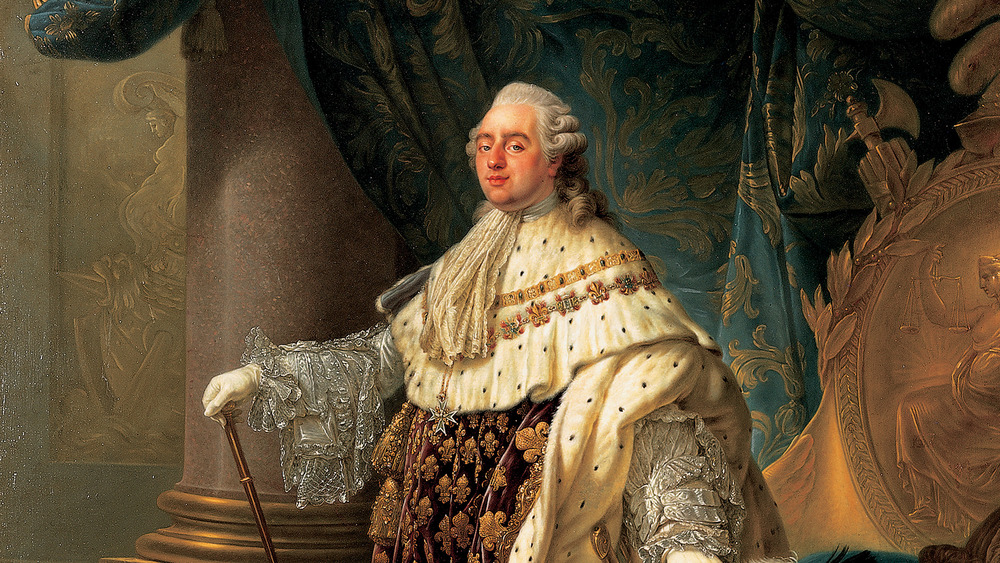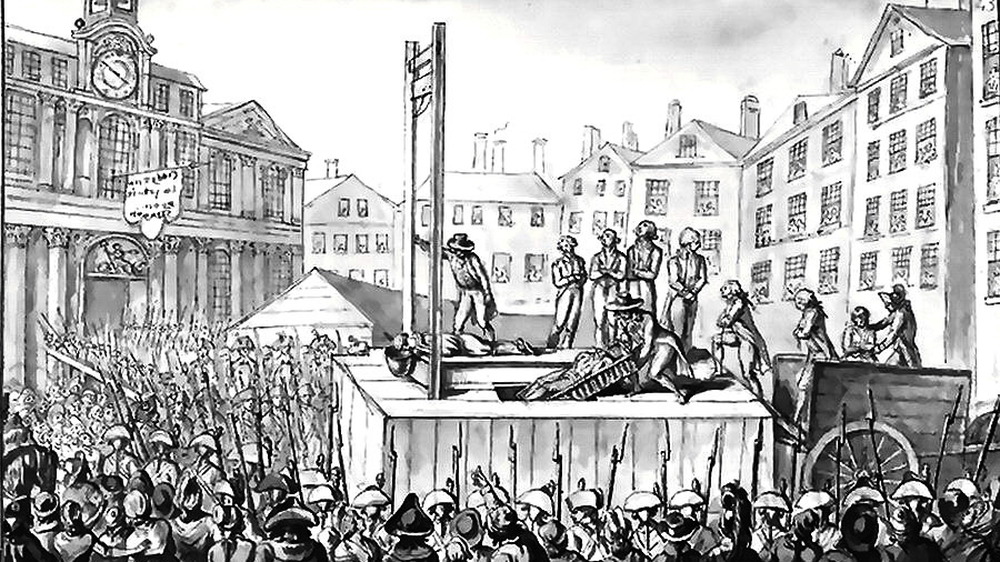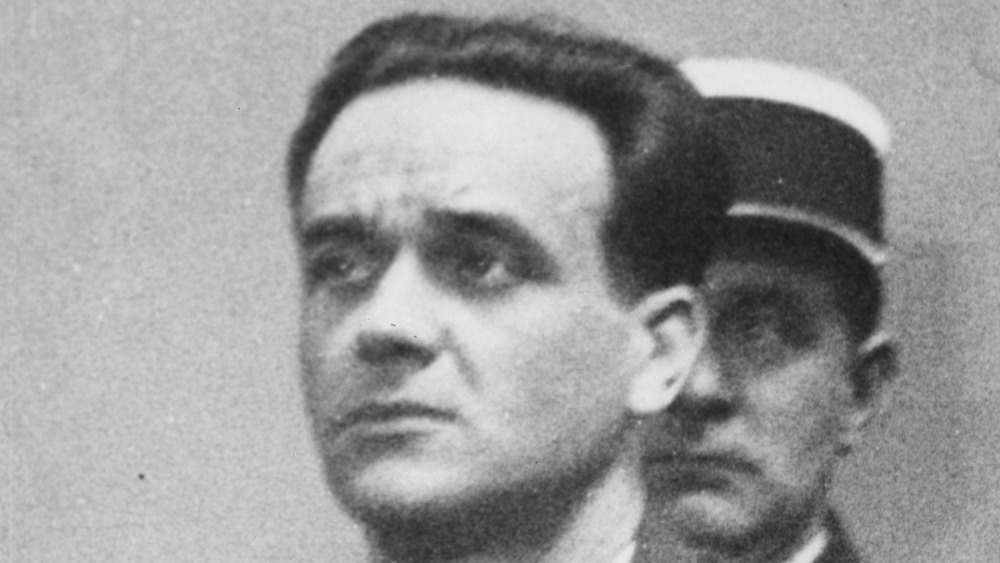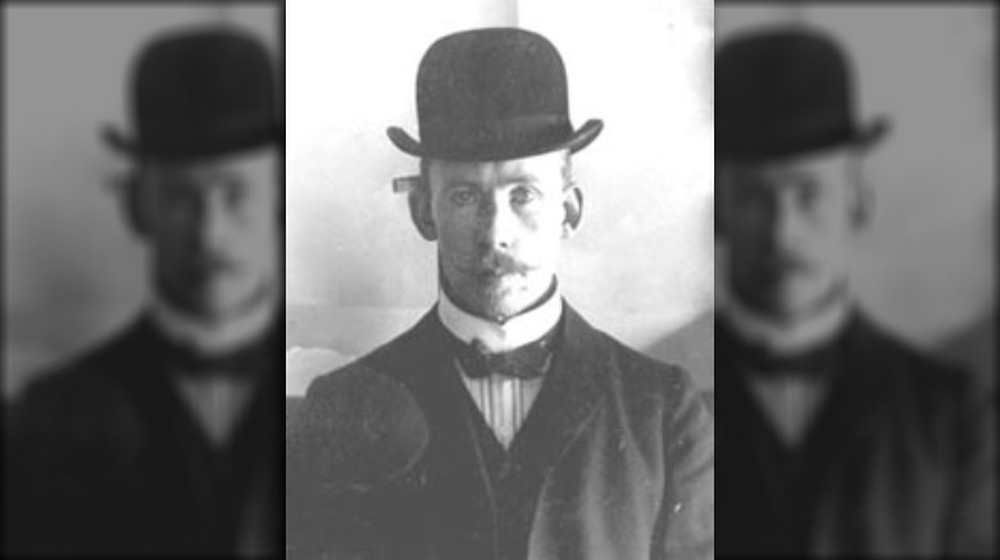Notorious Historical Figures Who Died By Guillotine
Even the possibility of being executed, let alone the reality, is horrible to contemplate for most people. Common fears for people are enclosed spaces, heights, and flying. People also fear the unknown, which definitely includes death. According to the Independent, there are also myths that, after beheading, heads glared or cheeks filled with color. That's pretty disturbing to think about as well.
The guillotine is a device that was specifically constructed to behead people mechanically. According to Britannica, it was introduced to the French in 1792, but similar instruments had been used in other countries, such as Britain and Scotland, for decades, mainly to kill prisoners born to the nobility.
France last used the guillotine for execution in the 1970s. The death penalty was abolished in 1981, according to French Diplomacy. This commitment was transferred into the constitution of the Fifth Republic in February 2007.
Louis XVI
Louis XVI was killed in January 1793 by guillotine, writes Biography. A financial crisis partly caused the French Revolution that lost him his crown — and his head. The revolutionaries were ready for change that Louis XVI wasn't able to provide.
Shy as a young man, Louis XVI was much more interested in woodworking and locksmithing. Historians have speculated that he suffered from depression and that it manifested itself as severe indecision — a travesty for a ruler of such a large country, especially one undergoing massive social upheaval as France was at the time. He, like his wife, Marie Antoinette, was not prepared to single-handedly pull France out of debt. Assisting the Americans with their revolution and separation from Britain also didn't help.
In 1792, Louis XVI hit upon the idea of a war with Austria to win back his shaky authority. This proved to be a bad plan and didn't work but instead led to suspicions of treason being bandied about. In November, he and his family were arrested, he and his wife specifically for treason due to their so-called secret dealings.
Louis XVI was quickly found guilty by the newly formed National Assembly and was beheaded on January 21 in the Place de la Revolution.
Louis Collenot d'Angremont
One of the depressing things about the guillotine is that it was actually invented to be more humane. French peasants, when sentenced to death, could die in very painful ways, such as being drawn and quartered or hacked at with a sword by an inefficient executioner. Therefore, the guillotine was the method that intended for everyone to be equal in death. It was democracy for murder!
Louis d'Angremont was a secretary in the National Guard, according to the Pocono Record. The first person in Paris to be guillotined to death, he supported the monarchy and participated in a so-called "conspiracy" against the government. He was executed on Aug. 21,1792, according to Discover Walks.
Louis d'Angremont was, effectively, the guinea pig for this new killing device. Obviously, the French revolutionaries found it satisfactory, as thousands of people were killed by guillotine during the French Revolution and afterwards. Unlike the murderers who make up a portion of this list, d'Angremont died for his beliefs — a particularly dangerous thing to be radical about during the French Revolution.
Maximilien Robespierre
Maximilien Robespierre was a Jacobin who engineered France's Reign of Terror during the French Revolution. Robespierre was elected to the Committee of Public Safety and organized thousands of deaths from 1793 to 1794, according to Biography.
He was interested in the writings of Jean-Jacques Rousseau and especially by the idea of a man against the world with only his conscience to guide him. He stuck to a very strict version of morality. Though Robespierre was against the death penalty, during the Reign of Terror, he was able to eliminate many of his political enemies. More than 17,000 people were executed from September 1793 to August 1794.
However, by the summer of 1794, many moderates and revolutionaries in the French government began to feel that Robespierre was going too far, since many enemies of the revolution had already been dealt with and killed. Therefore, in July 27, 1794, his opponents banded together to arrest him. Robespierre managed to escape to the Paris Hotel de Ville, attempted but did not succeed in killing himself, and was captured again when troops stormed the building. Robespierre was guillotined the next day.
Eugen Weidmann
Eugen Weidmann murdered six people, including a Brooklyn dancer. He was the last person to be publicly executed via guillotine in France, on June 17, 1939. British actor Christopher Lee witnessed his execution, which took place at the prison Saint Pierre on the rue Georges Clémenceau in Versailles (via Rare Newspapers). The building does still stand, though it no longer functions as a prison, according to Guillotine.dk.
The tilting board of the guillotine was not working properly that day, so three assistants needed to push Weidmann forward so that his neck was in the correct place (via Guillotine.dk).
Weidmann was born in Frankfurt am Main, Germany, in 1908 to an exports businessman, though he went to live with his grandparents when World War I broke out (via Rare Newspapers). He became a thief around this time and eventually made this his livelihood working with a group of three others to kidnap wealthy tourists and steal their money. Weidmann ended up murdering several of them, including the New York dancer Jean de Kloven, who had come to Paris for the 1937 World's Fair, according to Euro News.
The outcry at his execution was such that French President Albert Lebrun began to work to end public killings.
Christian Ranucci
Christian Ranucci was executed in Marseilles, France, in 1976, at the age of 22. He had abducted and murdered an 8-year-old girl two years prior. This execution was the first in France in two years, according to The Guardian, and it was also the 20th execution in the past 20 years.
Ranucci picked the girl up to give her a ride but crashed his car just minutes later, and according to him, panicked and lashed out. Though French President Giscard D'Estaing had indicated in his campaign that he was against the death penalty, he had been influenced by the Ministers of the Interior and Justice, who were calling for greater crackdowns on violent crimes.
The president seemed to be changing his views by the time the Ranucci case came around, though he stayed firm in cases where children were put into premeditated kidnapping situations where they were close to death. This made Ranucci's case contentious, since the girl's death was not necessarily premeditated. Several high-profile child murder cases happened around the same time in France, including Ranucci's. It's not surprising that public opinion guided so many decisions. Nonetheless, conservatives celebrated, and liberals despaired. France ultimately abolished the death penalty four years later.
Horst Fischer
Horst Fischer was a member of the SS during World War II and the doctor in charge of the Auschwitz and Buna/Monowitz concentration camps. He was responsible for "singling out" some 70,000 people, most of them those of the Jewish faith, to become slave labor or for the gas chamber. Fischer was arrested in 1965 by East German investigators, according to the Wollheim Memorial.
Fischer had rebuilt his life as a country doctor in East Germany living with his wife and four children after World War II, but eventually his carefully crafted lies fell apart. However, he wasn't on the radar for his actions during World War II but instead for too-frequent contact with people in the west.
His trial eventually became centered on the political struggle between East and West Germany. It was the most famous trial of SS officers in East Germany, according to Auschwitz.org. He was sentenced to death after a trial in 1966.
Jérôme Carrein
Jerome Carrein was an ex-convict and murderer of an 8-year-old schoolgirl. He was the second-to-last person executed in France on June 23, 1977, in a Douai prison courtyard, according to Executed Today.
Carrein was homeless and spent most nights in the swamps of Arleux. He begged from relatives, as well as a local bar. Unfortunately, that bar would absolutely come to regret helping him.
On Oct. 27, 1975, Carrein convinced the daughter of his barkeep friend to come with him to the swamp where he stayed. He apparently attempted to assault her, but she struggled, and he drowned her. Carrein confessed quickly, saying, according to Executed Today, "I saw red. I felt lost in the idea that she would denounce me, so I threw her in the pond."
Carrein was tried twice, both during other high-profile cases that bumped up the possibility of his getting the death sentence. One of those trials was of Christian Ranucci, and the other was a man named Patrick Henry, who had also murdered a child but only received life in prison.
Hamida Djandoubi
Hamida Djandoubi was a Tunisian convicted murderer in 1974. He tortured and murdered 22-year-old Elisabeth Bousquet by setting her on fire, strangling her, and abandoning her body in the countryside, writes Finding Dulcinea. While Djandoubi confessed to choking her and beating her, he said he couldn't really explain his reasons. He was guillotined in 1977 and was the last person to be executed in France.
Djandoubi suffered from depression and had lost part of his leg in an accident, according to When the Guillotine Fell: The Bloody Beginning and Horrifying End to France's River of Blood, 1791–1977, by Jeremy Mercer. If there had been extenuating circumstances, Djandoubi could have avoided the death penalty. Unfortunately, there were none. According to Finding Dulcinea, France was the last European country to use capital punishment.
Johan Alfred Ander
Johan Alfred Ander, a Swedish citizen, was convicted of robbery and murder at an exchange agency in Sweden in 1910. He was later found with blood-soaked bills, which was enough to sentence him, since the murder weapon had also been found, according to History.Info. The agency's employee was beaten so badly by the robber that she died. He is the only person Sweden has ever executed by guillotine.
Ander claimed that the bills had been given to him by a stranger, and he never confessed to the murder, but the courts all agreed on the charges and sentenced him to death, even though Sweden had never committed anyone to death via guillotine. The guillotine Ander was executed with was new, just from France, and the action took place at Stockholm's Långholmen Prison. Ander was reportedly calm on the day of his execution.
The execution apparently went smoothly. Sweden abolished the death penalty in 1921.
Joseph Auguste Neel
Joseph Auguste Neel was a fisherman on the island of St. Pierre in the North Atlantic Ocean, who decided to go out drinking with a friend, Louis Ollivier, in 1888. Afterwards, they went for dinner at the cabin of Ollivier's captain, expecting to find it empty. Instead, the cabin was locked, and they, not having the best judgment at the time, broke in. According to Dive Spell, they found the captain, Francois Coupard, there and stabbed him to death. The two apparently got into an argument over whether he was fat or big, to which they proceeded to dismember him to solve the myster (via St. Pierre and Miquelon).
After the trial the next year, Ollivier was sentenced to ten years of hard labor, while Neel was executed by guillotine on the island of St. Pierre. He is the only person to be guillotined in North America, according to Executed Today.
St. Pierre had never had an execution, but that didn't stop French law from providing a solution. Someone in Martinique had to take apart and ship a guillotine to St. Pierre, just so Neel could be executed. Limb separation is plenty scary, but it would seem to be even more terrifying, knowing that one specific machine was being sent to our home to do us harm, on the express orders of the government.
Marie Antoinette
Marie Antoinette lived nearly a year longer than her husband, Louis XVI, and was executed in October 1793. An Austrian archduchess by birth, she had never been terribly popular in France, first for her childlessness and later for her spending and capriciousness, according to Biography. Historians argue that the famous line that supposedly belongs to her, "Let them eat cake!" she never actually said.
However, like Louis XVI, she was unprepared to do what needed to be done to heal France. For most of her life, the main purpose was to have children for the crown. Marie Antoinette was not a politician, and unfortunately, both of her sons died young.
When given her sentence of execution at 4:30 a.m. on October 15, the former queen didn't say a word. She was guillotined at 12:30 p.m. the next morning, according to History Extra.
Marie Antoinette and Louis XVI left behind their two children, only one of whom survived — their oldest daughter, Marie Therese. Their son, Louis Charles, died while in prison, either from abuse or neglect (via History). By the time Marie Antoinette was executed, the Reign of Terror had already been ongoing for a month.











